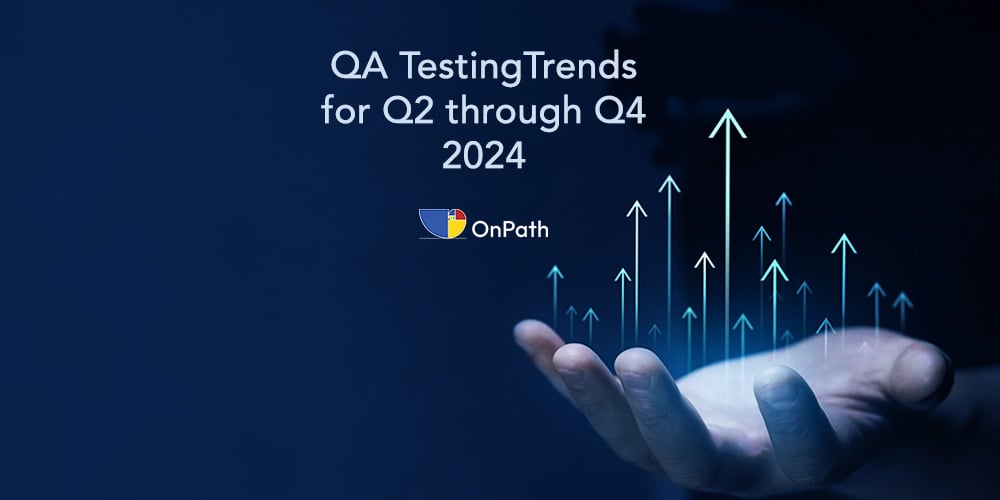As we head into the second quarter of 2024, there are several important trends to work into your QA testing process. The list of 2024 trends is extensive and focused on ways to deliver quality at speed while improving customer experience. Most teams have time enough to explore one or two of these new processes for continuous improvement.
Explore the trending topics in QA testing below and consider the most important ones for your business needs. It’s unlikely you’ll get them all incorporated into your QA testing processes within a year, so prioritize which ones make sense for your team.
Priorities for Delivering Quality at Speed
Application release quality and testing speed are often at opposite ends of the spectrum. In today’s testing, speed is a necessary reality. The trick is finding the right processes to add speed and efficiency while balancing test coverage and effectiveness.
-
Continuous QA
Continuous QA is typically implemented as a CI/CD (continuous integration/continuous development) solution. When you move towards continuous QA, you’ll not only upgrade your test organization and speed but impact how automated tests are developed and managed. You may find yourself improving both your QA testing efficiency and effectiveness within a highly collaborative and automated SDLC.
-
Agile with Shift-Left
The Shift-Left flavor of Agile takes you back to the days of extreme programming. The focus is on producing a quality application at high speeds by focusing on testing as soon as development begins. The idea is to practice Agile concepts and take advantage of finding defects early and often. Modern software development organizations use Shift-Left practices to maximize testing without negatively impacting release schedules or application quality.
-
QAOps
QAOps is essentially DevOps but with a focus on the collaborative partnership of QA testing and operations (release deployment and implementation). Organizations that adopt QAOps or DevOps typically practice continuous testing in a CI/CD process. If you adopt QAOps, expect to also upgrade your automated test development to leverage AI and ML technology.
Priorities for Expanding Test Coverage
Expanding test coverage capacity is critical as testing becomes increasingly compact. Now’s the time to consider adding the following to your testing repertoire to ensure the QA testing team is ready for testing increasingly complex software applications.
-
Data Testing
Today’s applications move massive amounts of data through APIs, microservices, and other transfer methods. Data testing requires end-to-end application testing to avoid missed connections, vulnerabilities, and outright failures. The variety and complexity of data are increasing as is the need to test and verify data ingestion, storage, processing, analysis, visualization, and modeling. Data impacts application functionality as well as business analytics, and analytics are critical for growing and managing a successful business.
-
Cloud-Native Testing
Cloud-native testing refers to testing cloud-based applications that are created using cloud-native principles and technology. Testing cloud systems ensures the reliability, security, and end-to-end functionality of cloud applications and the platform that enables their operation. Cloud-native testing includes verifying scalability within dynamic cloud systems.
-
Augmented and Virtual Reality Testing
As Augmented (AR) and virtual (VR) reality technology expands it will directly impact QA testing. QA testing teams will have to plan additional testing to cover the multiple uses for AR and VR. ECommerce, healthcare, entertainment, education, and gaming are heavy current and future users. AR and VR will expand both UX and QA testing as more applications take advantage of what AR and VR technology can do to reach and connect with customers.
Priorities for Managing Test Environments
Providing high-quality testing at speed requires the ability to manage multiple testing environments and test data easily and accurately. It also requires consistent and standard practices that ensure the quality and accuracy of testing.
-
Leveraging Containerization for Reliable Test Environments
Modern application testing needs the reliability and ease of containerized test environments. Containers enforce consistency and improve collaboration, especially for efficient test automation and manual testing. Containerization enables testers to spin up environments when needed with less hassle and without overly complex processes. Test environments are simpler to create and keep updated including test data refreshes. Containerization offers a quick and consistent environment setup for accurate test results.
-
Testing Center of Excellence (TCoE)
TCoEs are a blast from the past. TCoEs are popular and important to maintain quality testing processes in a world where release-to-market speed is a top priority. Many Agile organizations use the term ACoE (Agile Center of Excellence) and incorporate testing into development. The important part is the structure that makes an Agile process collaborative, organized, and successful.
As QA testing moves forward there is a continuing need to adapt to new technology, increasing application complexity, and varied testing efforts. The future requires collaboration between QA testing teams, development, operations, and UX/UI designers. Creating customer-centric applications that exceed customer expectations is the recipe for application success. The trick is providing effective, consistent, and efficient testing with less time from development to deployment. Consider adding one or more 2024 trends to your process and deliver quality to customers at the speed of business.



